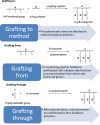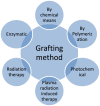Polymer Grafting and its chemical reactions
- PMID: 36714621
- PMCID: PMC9874337
- DOI: 10.3389/fbioe.2022.1044927
Polymer Grafting and its chemical reactions
Abstract
Polymer grafting is a technique to improve the morphology, chemical, and physical properties of the polymer. This technique has the potential to improve the existing conduction and properties of polymers other than charge transport; as a result, it enhances the solubility, nano-dimensional morphology, biocompatibility, bio-communication, and other property of parent polymer. A polymer's physicochemical properties can be modified even further by creating a copolymer with another polymer or by grafting. Here in the various chemical approaches for polymer grafting, like free radical, click reaction, amide formation, and alkylation have been discussed with their importance, moreover the process and its importance are covered comprehensively with their scientific explanation. The present review also covers the effectiveness of the graft-to approaches and its application in various fields, which will give reader a glimpse about polymer grafting and its uses.
Keywords: azide-alkyne cycloaddition; click chemistry; drug polymer interaction; grafting; polymerization.
Copyright © 2023 Purohit, Bhatt, Mittal, Abdellattif and Farghaly.
Conflict of interest statement
The authors declare that the research was conducted in the absence of any commercial or financial relationships that could be construed as a potential conflict of interest.
Figures


















References
-
- Ajaz N., Abbas A., Afshan R., Irfan M., Khalid S. H., Asghar S., et al. (2022). In vitro and in vivo evaluation of hydroxypropylβ-cyclodextrin-grafted-poly(acrylic acid)/poly(vinyl pyrrolidone) semi-interpenetrating matrices of dexamethasone sodium phosphate. Pharmaceuticals 15, 1399. 10.3390/ph15111399 - DOI - PMC - PubMed
-
- Arslan H. (2012). Polymerization. London, UK: InTechOpen, 279–320.Block and graft copolymerization by controlled/living radical polymerization methods
-
- Awad S., Alomari A. H., Abdel-Hady E. E., Hamam M. F. (2021). Characterization, nanostructure, and transport properties of styrene grafted PVA/SiO2 hybrid nanocomposite membranes: Positron lifetime study. Polym. Adv. Technol. 32 (4), 1742–1751.
Publication types
LinkOut - more resources
Full Text Sources

